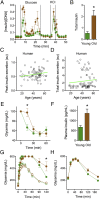Young capillary vessels rejuvenate aged pancreatic islets
- PMID: 25404292
- PMCID: PMC4267392
- DOI: 10.1073/pnas.1414053111
Young capillary vessels rejuvenate aged pancreatic islets
Abstract
Pancreatic islets secrete hormones that play a key role in regulating blood glucose levels (glycemia). Age-dependent impairment of islet function and concomitant dysregulation of glycemia are major health threats in aged populations. However, the major causes of the age-dependent decline of islet function are still disputed. Here we demonstrate that aging of pancreatic islets in mice and humans is notably associated with inflammation and fibrosis of islet blood vessels but does not affect glucose sensing and the insulin secretory capacity of islet beta cells. Accordingly, when transplanted into the anterior chamber of the eye of young mice with diabetes, islets from old mice are revascularized with healthy blood vessels, show strong islet cell proliferation, and fully restore control of glycemia. Our results indicate that beta cell function does not decline with age and suggest that islet function is threatened by an age-dependent impairment of islet vascular function. Strategies to mitigate age-dependent dysregulation in glycemia should therefore target systemic and/or local inflammation and fibrosis of the aged islet vasculature.
Keywords: aging; glucose metabolism; insulin secretion; pancreatic islets; vasculature.
Conflict of interest statement
Conflict of interest statement: P.-O.B. is one of the founders of the biotech company Biocrine, which is going to use the anterior chamber of the eye as a commercial servicing platform. A.C. holds a patent on this servicing platform. M.H.A. is a consultant of Biocrine.
Figures





References
-
- Chang AM, Halter JB. Aging and insulin secretion. Am J Physiol Endocrinol Metab. 2003;284(1):E7–E12. - PubMed
-
- Gumbiner B, et al. Effects of aging on insulin secretion. Diabetes. 1989;38(12):1549–1556. - PubMed
-
- Ihm SH, et al. Effect of aging on insulin secretory function and expression of beta cell function-related genes of islets. Diabetes Res Clin Pract. 2007;77(Suppl 1):S150–S154. - PubMed
-
- Leiter EH, Premdas F, Harrison DE, Lipson LG. Aging and glucose homeostasis in C57BL/6J male mice. FASEB J. 1988;2(12):2807–2811. - PubMed
Publication types
MeSH terms
Substances
Grants and funding
LinkOut - more resources
Full Text Sources
Other Literature Sources
Medical

